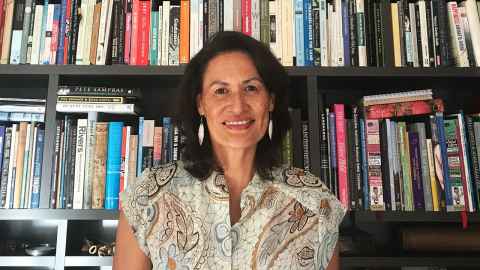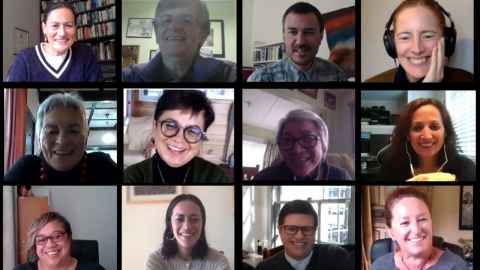To see a face is to stir the emotions
29 September 2021
Kaumātua and kuia have a special place in Māori society that needs to be acknowledged in a time when Covid 19 forces changes to tikanga.


A tangihanga is underway at Level 4 lockdown. The strong need is to be present to farewell the departed. The rules say otherwise. Kaumātua felt a dereliction of their duty. “I’m their kaumātua and I couldn’t even be there,” one said.
Others spoke of standing alongside the route of the hearse as the tūpāpuku, the deceased, passed. Their marae was closed, and they could no longer stand together at the wāhi tapu, the cemetery.
A kuia recounts how she and a friend did their best, standing by the side of the road, calling out with their karanga, as the hearse passed and then standing at a safe distance outside the wāhi tapu. “We stood within hearing range in order to show our respect to the family,” said the kuia.
A tangihanga is like a story. The rules the pandemic brought disrupted the narrative. There is no ability to have a loved one lie at rest on the marae before burial. Numbers are severely limited for services. And the conclusion of a tangi, the hākari, the customary time to feast together following the internment, no longer happens. The dilemma is captured in the saying 'He kitenge kanohi, he hokina mahara', 'To see a face is to stir the emotions'.

A kaumātua named Tane talked of the importance of hākari in lifting the tapu of visitors to the marae. “There should be a whakanoa (tapu lifting) after the visitors arrive and the whakanoa is having kai. That lifts the tapu of our manuhiri. So, it’s going to be hard not to do that, it’s so much a part of our tangi.”
These observations are part of a treasure trove from the voices of kaumātua as told to a research team led by Associate Professor Marama Muru-Lanning, the Director of the James Henare Centre for Māori Research at the University of Auckland.
The title of their report Harirū, hongi and hau: Kaumātua in the time of Covid 19 encapsulates the essence of the dilemma felt by Māori confronted by death during the 2020 lockdowns. Tikanga for tangi instilled over generations as the full expression of the Māori world view had to be dispensed with to protect the vulnerable. Their sadness and respect expressed through tears, hugs and the sharing of breath became a highly transmissible source of infection.
The 23 kaumātua from Ngāti Wai and Waikato-Tainui who gave their time and insights form the basis of the report. For Muru-Lanning, the research, funded by the Health Research Council, needed to be two way. The researchers would ask questions, identify themes, and draft conclusions.
But it was also a way for the voice of kaumātua to be heard by policy makers in Wellington. For Muru-Lanning the report offers Wellington a window into what it means for kaumātua and marae to adapt to the pandemic. The research team adopted a co-design approach, involving three community-based researchers, Professor Ngapare Hopa, Dr Ngahuia Dixon (Waikato-Tainui) and Cilla Moore (Ngātiwai), known as the ‘Whaea’ or aunties.
Of the experience of lockdown itself, they thought first of their whānau and how to protect them.
Most of the kaumātua lived independently in their own homes, sometimes if widowed, with a family member, an adult child or mokopuna (grandchild.) They told of stories handed down from past epidemics, the Spanish influenza and tuberculosis. Of the experience of lockdown itself, they thought first of their whānau and how to protect them.
Kuia Teina said her first thoughts cast back to memories of her grandfather. “How in our little kitchen in his whare with all of us mokopuna around him. Telling us stories about the war, the First and Second World Wars. I got that mokemoke, that loneliness feeling, as I sat here in my house thinking about it. And the loneliness for my family came, my family in Perth, my three girls, my mokopuna they’re all over there.”
In the isolation connection remained and sometimes improved. Ngahuia said her relationship with her grandson and his wife, who lived with her grew deeper. They worried about her. “They used to pop into my room and say, ‘Nana, are you ok, do you want anything, are you alright, are you warm?’ And I said, ‘Yes, I’m still around.’”
With no visitors, technology like Zoom, Messenger and other platforms came into play, with younger relatives helping their elders bridge technical gaps. Muru-Lanning describes this as the Te Whare Pūngāwerewere, the webs of connection.
The 1918 influenza epidemic struck New Zealand in October 2018. In three months, it accounted for some 9000 lives, more than half the number of New Zealanders killed in the entire First World War, before it began to abate.
Just as keenly felt was the loss of the ability to meet on the marae and the difficulty in maintaining the customs of tangi. The kaumātua acknowledged that tikanga had changed, affecting their roles.
For a marae to close is a serious and rare event. Muru-Lanning grew up across the road from Turangawaewae Marae, the home of the Kingitanga in Ngaruawahia. Well before the Government put the country into lockdown, the marae decided to close to protect its elders. She cannot remember it ever happening in her lifetime.
The story of Turangawaewae marae shows how the memory of previous epidemics informed the heartland Māori response to the Covid pandemic, from semi-official roadblocks to prevent visitors to areas of vulnerability, to the use of marae when safe to distribute food and care packages to communities particularly hard hit by the loss of jobs and income.
The 1918 influenza epidemic struck New Zealand in October 2018. In three months, it accounted for some 9000 lives, more than half the number of New Zealanders killed in the entire First World War, before it began to abate.
Māori were disproportionately affected. Muru-Lanning’s family originally came from Ngāti Whatua and the Kaipara. “There was no food, there was nothing and there were all these children without parents,” she says.
Put the mana back into the leadership of Māoridom.
It was a terrible time and leader Te Puea Herangi, better known as Princess Te Puea responded. She established Turangawaewae marae as a home for orphans and devastated families. Muru-Lanning’s grandfather and grandmother heeded that call to help. “They set up their home there and our house is right across the road from the marae gate so I’m truly embedded.”
This year, the second of the Covid pandemic, it will be 100 years since the establishment of Turangawaewae marae, a response to an earlier devastating pandemic. Muru-Lanning: “People from there (Turangawaewae), they understand pandemics and the need to change behaviours.”
The research has been presented in Wellington. Muru-Lanning wants it to inform how kaumātua specifically can be involved in central Government decisions to change tikanga. She acknowledges the need for decisions and policy from Wellington. “People really appreciate how Bloomfield and Ardern communicate and their commitment to the kaupapa of health first and foremost. But there are times when one size does not fit all.”
She’s not saying a Māori structure would come up with different decisions, but the process of coming to consensus would acknowledge the role of kaumātua. She describes a dual leadership process in Māori society. “The kaumātua might not be making the decisions, but they are present and listened to. Their presence is important. For a meeting to go well or to have mana you must have the kaumātua present.”
Their presence means the decisions are accepted by the group, and collective decisions are more likely to have broader acceptance. Muru-Lanning says: “We do get that we need to protect the kaumātua. But at the same time, they were left as only being fragile and vulnerable. They didn't have their voice.”
By creating the means to include kaumātua in consultation and ensuring the voice of Māori is visible in communicating decisions from Government, would as one kaumātua said, “Put the mana back into the leadership of Māoridom.” Muru-Lanning is optimistic by nature. The research has created a platform for the voice of kaumātua. Now it is time to listen.
Story by Gilbert Wong
Mātātaki|The Challenge is a continuing series from the University of Auckland about how researchers are helping to tackle some of the world's biggest challenges. To republish this article please contact: gilbert.wong@auckland.ac.nz